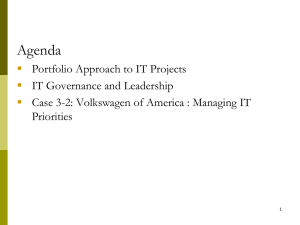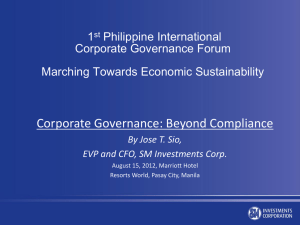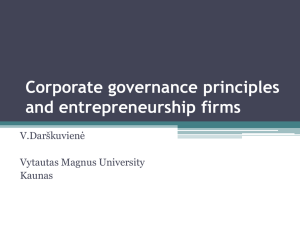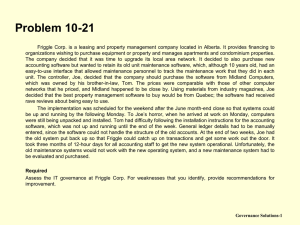Auditing Governance Functions
advertisement
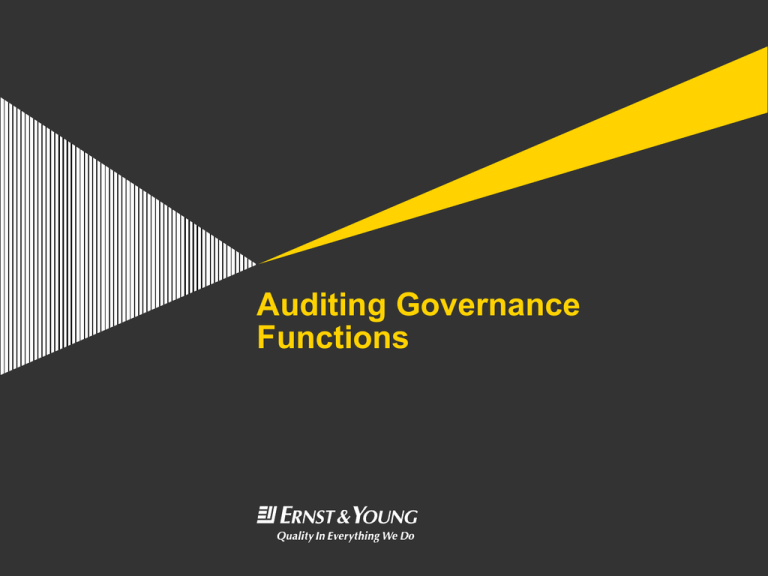
Auditing Governance Functions Agenda ► Defining Corporate Governance ► Internal Audit’s Role in Corporate Governance ► Areas of Audit Focus ► Regulatory Considerations Page 2 Auditing Governance Functions Governance Functions ► Regulatory and rating agency landscape has changed, with an increased scrutiny on Governance functions, such as: ► ► ► ► ► Page 3 Board / Governance Reporting Enterprise and Operational Risk Management Technology Emerging Risks Continuous Monitoring Auditing Governance Functions Corporate Governance ► Governance is the combination of processes and structures implemented by the board to inform, direct, manage, and monitor the activities of the organization toward the achievement of its objectives. ► ► ► ► ► ► ► ► Page 4 Board of Directors Audit and Risk Committees Corporate Committee Structure Management Enterprise Risk Program Compliance and Regulatory Program Technology Program Social Responsibility Program Auditing Governance Functions Internal Audit’s Role in Governance ► Internal Audit’s role in governance is as follows: ► Independent testing and verification of efficacy of corporate standards and business line compliance ► Validate the overall risk framework ► Provide assurance that the risk management process is functioning as designed and identifies improvement opportunities Through its dual consulting and assurance roles, internal audit can provide tremendous value to a dynamic organization by focusing on areas of greatest exposure, complex operations and key business initiatives, to validate that the organization is well controlled and operating effectively and efficiently to meet the strategic goals of the firm. Page 5 Auditing Governance Functions Governance Functions ► Internal audit must assess and make appropriate recommendations for improving Governance in its accomplishment of the following objectives: ► ► ► ► Page 6 Promoting appropriate ethics and values within the organization Ensuring effective organizational performance management and accountability Communicating risk and control information to appropriate areas of the organization Coordinating the activities of and communicating information among the board, auditors, and management. Auditing Governance Functions Enterprise Risk Management ► Enterprise Risk Management Considerations ► ► ► Page 7 Commensurate with size, risk profile, complexity, and growth of the enterprise Provide increased business awareness Incorporate risk considerations in decision making across enterprises Auditing Governance Functions ERM Framework Step 1: Establish ERM Framework •Identify Project Champion •Identify Project Owner •Establish Steering Committee Step 2: Identify Key Objectives •List Key Objectives •Prioritize Key Objectives •Select objectives for assessments Step 3: Identify Key Risks •Assess Risk •Assign Risk Rating Step 4: Manage Risk •Identify Control Controls and Mitigation Requirements •Develop Mitigation Plans for key risks •Perform periodic status reviews •Repeat steps 2 – 4 for additional control objectives Page 8 Auditing Governance Functions Enterprise Risk Management ► No formal framework to identify, prioritize and communicate risks ► No ongoing risk monitoring and/or risk management enhancement activities ► Risk appetite not articulated or defined ► Lack of aware awareness of Enterprise Risk Appetite ► Failure to communicate with executive management, audit committee, and business units on a consistent and formal basis to discuss expectations, business strategies, objectives and initiative ► Policies and procedures do not exist, are not documented, are inadequate or are not followed Page 9 Auditing Governance Functions Enterprise Risk Management (continued) ► Performance goals and objectives drive behavior inconsistent with overall Enterprise ethics or standards Page 10 Auditing Governance Functions Corporate Social Responsibility (CSR) ► CSR: The way firms integrate social, environmental, and economic concerns into their values, culture, decisionmaking strategy and operations in a transparent and accountable manner and thereby establish better practices within the firm and contribute towards society improvements. ► Responsibility : ► ► ► Page 11 Board of Directors CSR Executive Management Auditing Governance Functions CSR Risks ► Reputational Risk ► Compliance Risk ► Operational Risk ► Liability Risk ► External Business Relationships Risk Page 12 Auditing Governance Functions CSR Risks (continued) ► Reputational Risk ► ► ► ► Violations of law or principles Errors or omissions in disclosed CSR information Under-performance compared with objectives/targets Appearance of indifference to social issues ► Compliance Risk ► Failure to comply due to the extent, complexity, and volume of regulations relating to the environment, health and safety, employment, governance, political contributions, conflict of interest, and fraud. ► Contractual obligations with third parties, such as customers, unions, or employees, and from voluntary adoption of standards. Page 13 Auditing Governance Functions CSR Risks (continued) ► Operational Risk ► CSR “pressure points” for the organization’s manufacturing processes, products, services and impact on the environment. ► Under-performance of other targets due to inappropriate CSR strategies, or over-emphasis on CSR strategies. ► Failure to integrate CSR objectives into processes, or to educate staff appropriately. ► Failure to develop well-controlled systems for CSR initiatives. ► Inaccurate or incomplete reporting information. ► Challenge to apply same standards across multiple countries. Page 14 Auditing Governance Functions CSR Risks – contd. ► Liability Risk ► During contracting for CSR terms and conditions and ensuring third-party compliance. ► Activists or specific classes/special interest groups may take legal action for alleged harm done by the organization. ► External Business Relationships ► Customers, suppliers, or partners could violate CSR terms and conditions, principles, or laws, yet the organization could be included as a wrongdoer by association. Page 15 Auditing Governance Functions Technology IT governance follows a lifecycle IT governance should not be a one-time exercise Understanding the as-is governance structure enables the organization to make only the necessary changes ► Building principles based on organization-specific drivers is the basis for a working governance model ► The governance principles will act as the foundation of the governance framework and set the scene for the later model ► After running through the lifecycle once, organizations are able to iterate the governance lifecycle without external support ► Page 16 Auditing Governance Functions IT governance decision areas IT principles IT investments IT architectures Applications IT infrastructure ► ► ► ► ► ► ► ► ► ► How is IT used within the business Providing direction for IT delivery Determine the total IT spend Prioritising conflicting investment needs Organisation and structure of IT assets Approach to integration of IT assets How to support business processes Software platforms Enabling applications and architecture Managing IT assets ► Governance decisions are either taken centralised or decentralised ► By business, IT or both of them ► Mechanisms have to be aligned to organizational and operations model as well as IT strategy Page 17 Auditing Governance Functions Aligning business and IT on different levels Business level IT level Board, CEO, COO IT Executive Steering Committee CIO, CTO, senior IT management Approve Business management IT Governance Council IT management Decide Business process owner IT Governing Bodies: Architecture and technology boards IT client manager architecture owner Design Key user IT Governing Bodies: Service delivery boards Service manager Facilitate Business process frameworks Page 18 Joint IT governance boards Service delivery through business and IT Auditing Governance Functions IT service management frameworks e.g. ITIL IT governance domains Leadership Monitoring and control ► Setting the overall direction for IT within the corporation ► Maintaining cultural values, corporate image and voice Planning ► Representing corporation’s key IT stakeholders ► Developing IT strategy including sourcing philosophy ► Qualitative benchmarking ► Managing service levels ► Managing a penalty system ► Build corporate IT organization ► Identifying areas for service improvement ► Setting corporate IT goals ► Agreeing on IT performance targets with IT customers IT governance Coordination and compliance Capital allocation ► Ensuring compliance with IT standards and obligations ► Coordinating IT activities between IT demand and supply ► Page 19 Policy ► Setting the fundamental IT operating procedures ► Establishing standards, rules and guidelines ► Defining technical and application architectures Coordinating IT deployment Auditing Governance Functions ► Determining capital available ► Determining IT investment criteria ► Reviewing bids for capital ► Allocating resources Technology Governance Considerations Inherent key IT risks IT objectives and strategies IT processes Infrastructure and asset management IT development and design Technology enablement to achieve business objectives Superior service support and delivery IT operations Continuity of services Optimize operating efficiency Information security and protection Protection of information Effectively manage security risk Page 20 Auditing Governance Functions ► Emerging technologies ► Technology direction ► System disruptions ► Contracts/3rd party vendors – outsourcing ► Records retention ► Regulatory compliance ► People management ► Global sourcing ► Business continuity ► Asset and portfolio management ► IT infrastructure capacity ► IT security/privacy ► Financial reporting Evaluate management and control activities Deliver superior Systems and applications ► IT process duplication and inefficiencies Link risks to IT processes Strategic planning Link objectives to risks IT governance and strategy Evaluate the significance of the risk to IT objectives Guidance and oversight Change management Service level management Production support Security and data management Problem and incident management Project/program management Customer support Regulatory Expectations ► Failure to establish and maintain an internal control environment which aligns stakeholders and regulatory expectations ► Failure to identify relevant laws and regulations ► Lack of procedures to comply with applicable laws and regulations ► Insufficient or inadequate training of staff on regulatory requirements ► Failure to establish adequate working relationship with regulators or authorities Page 21 Auditing Governance Functions Thank you! ► Questions? Page 22 Auditing Governance Functions


